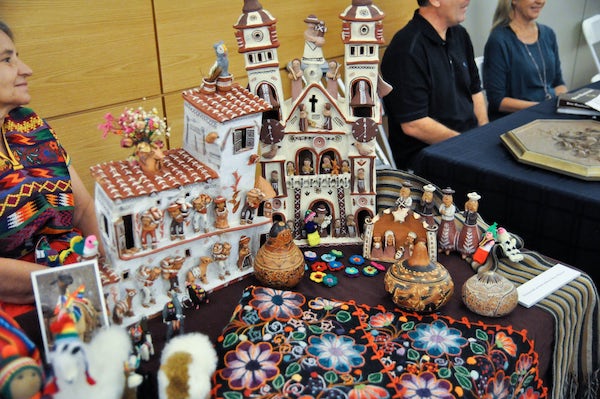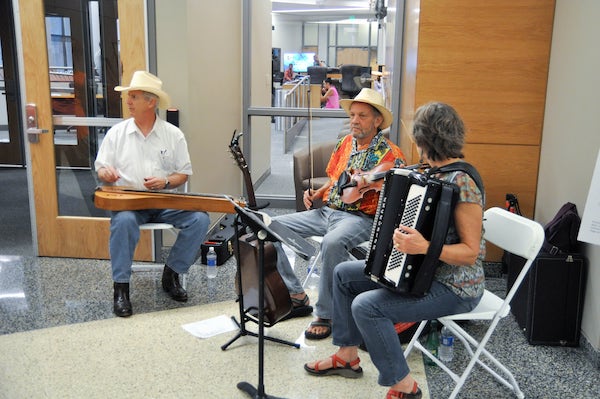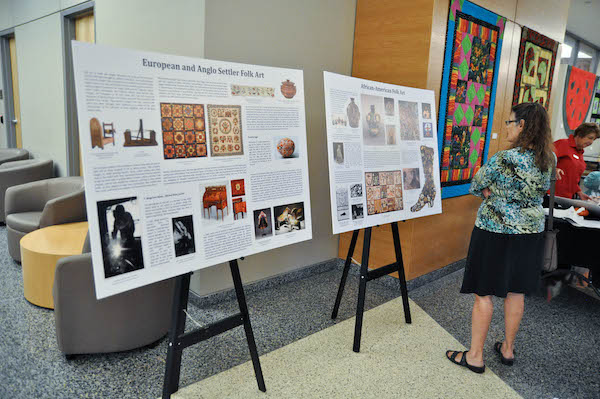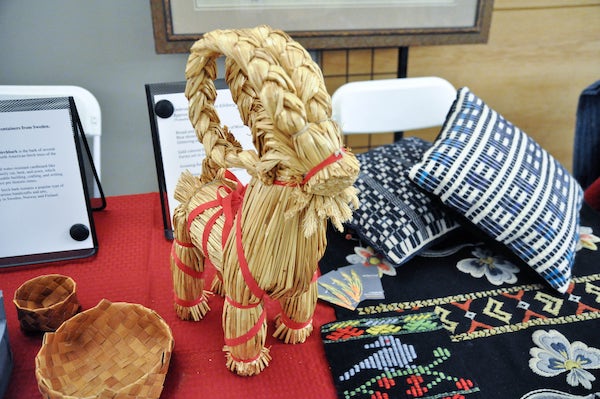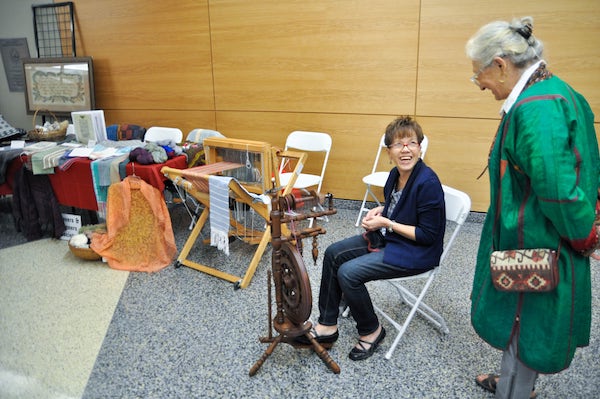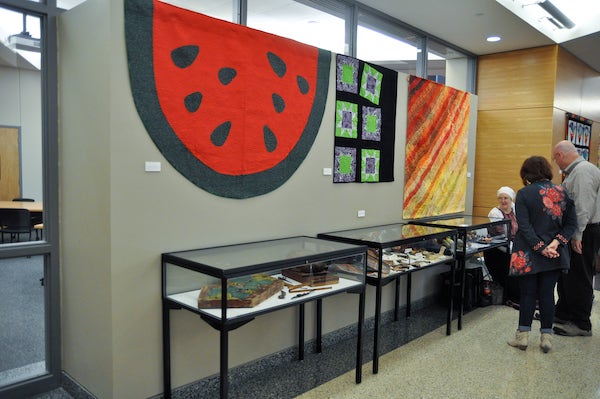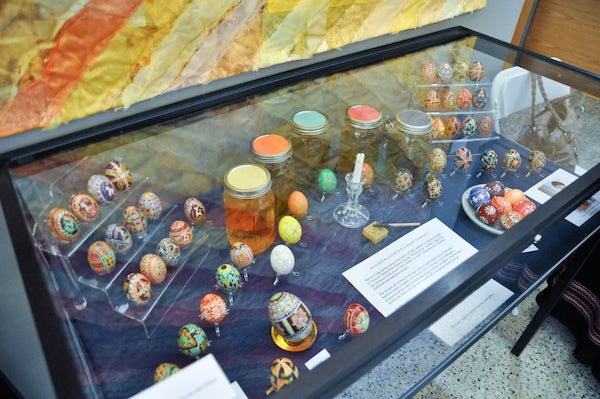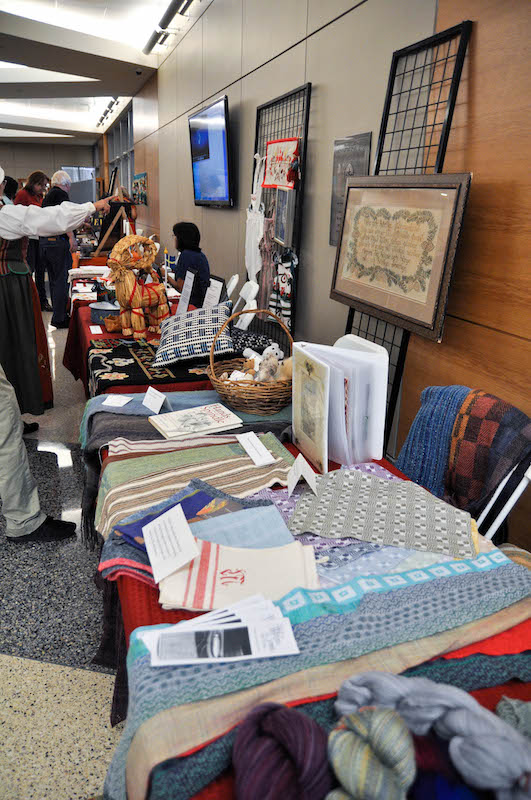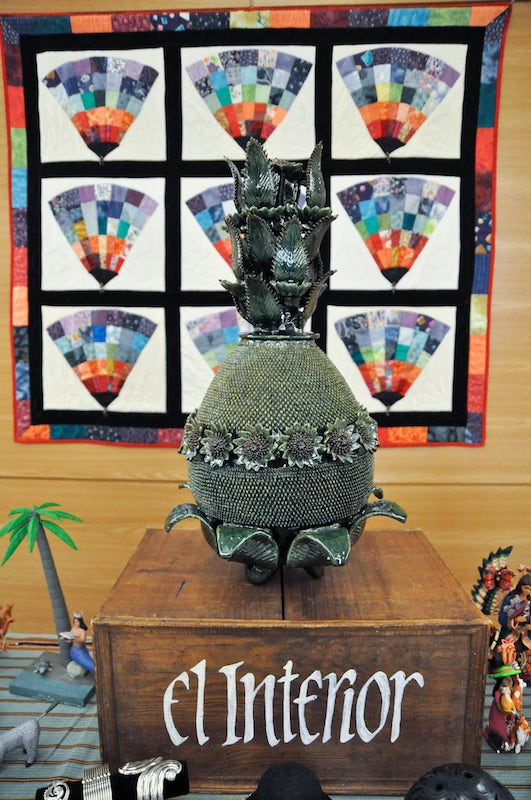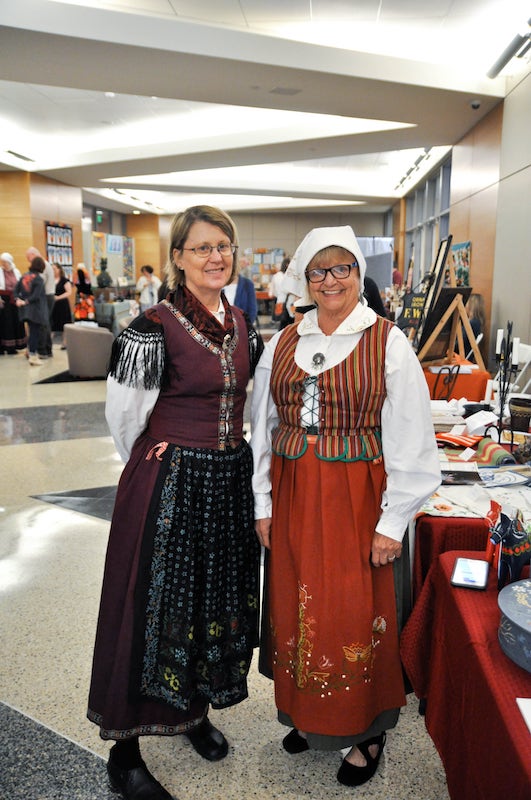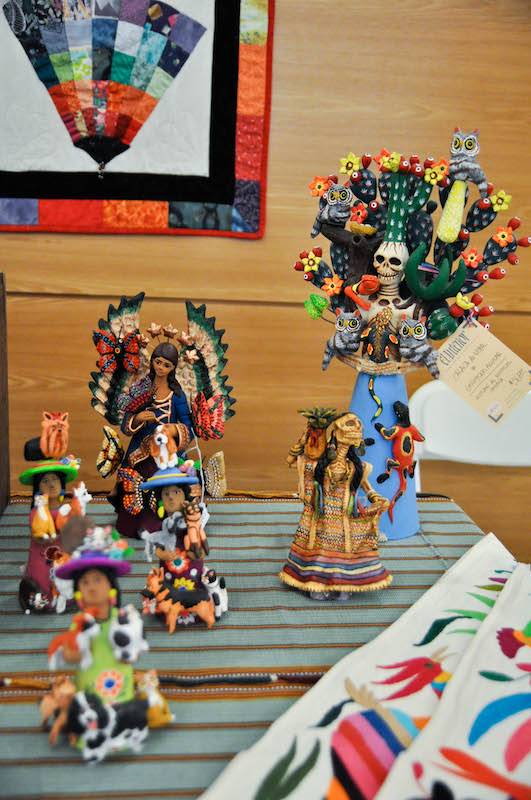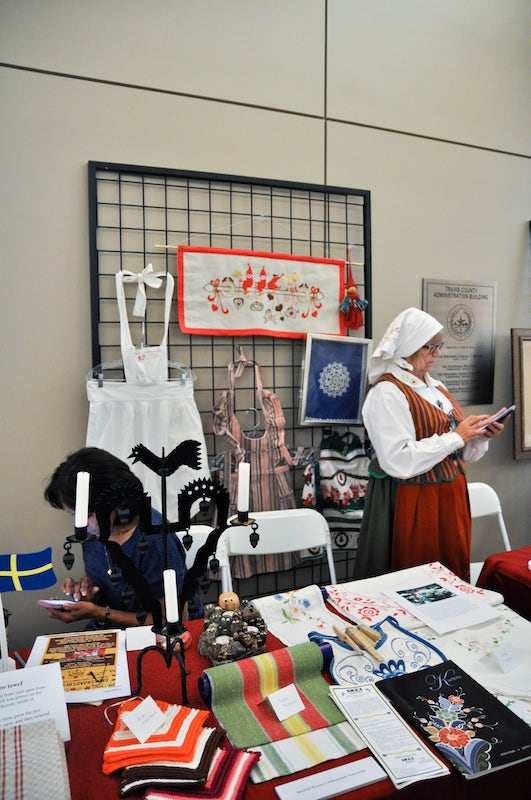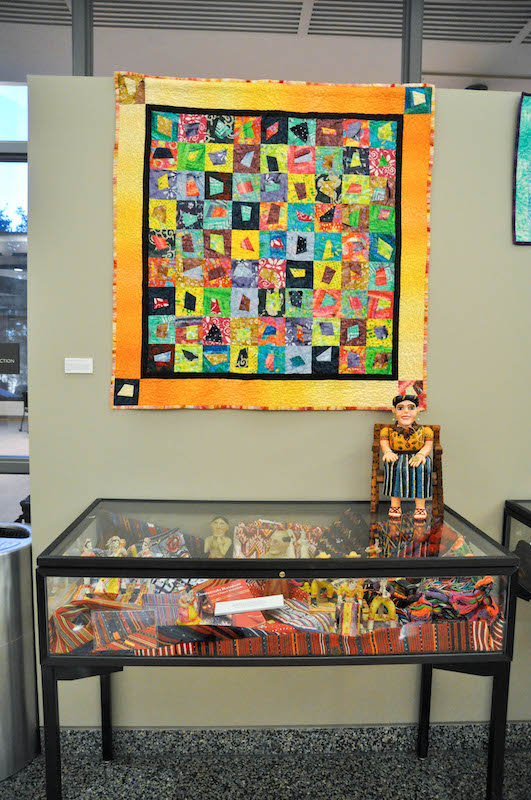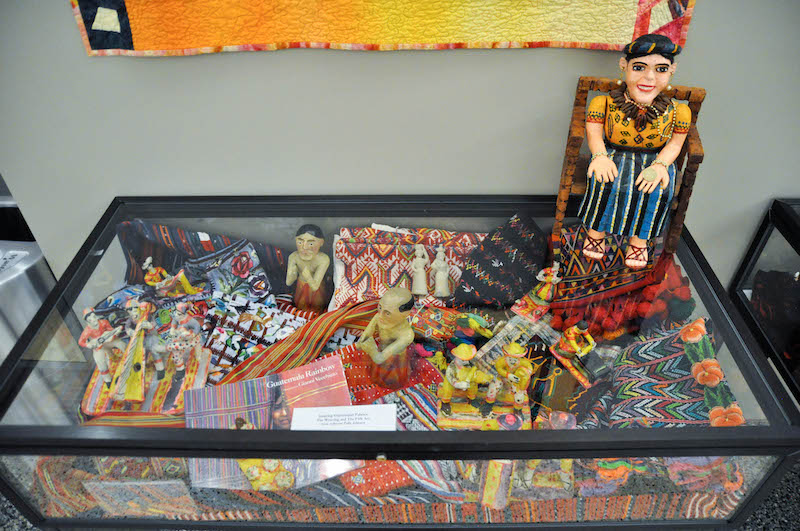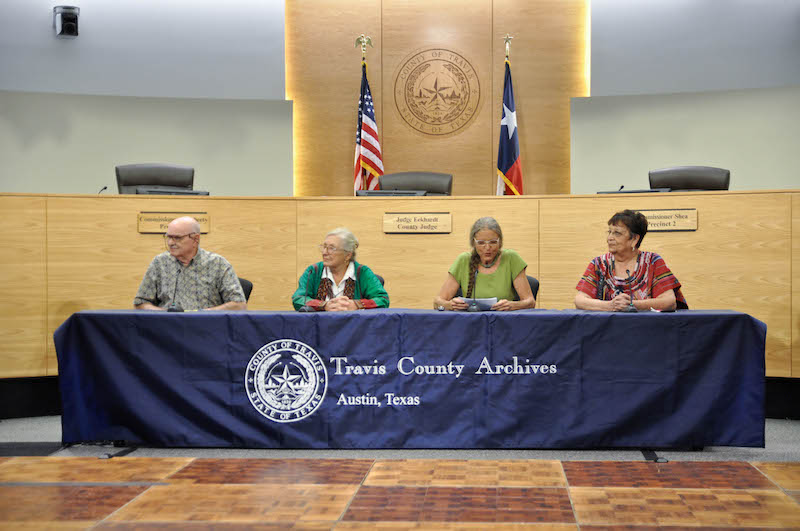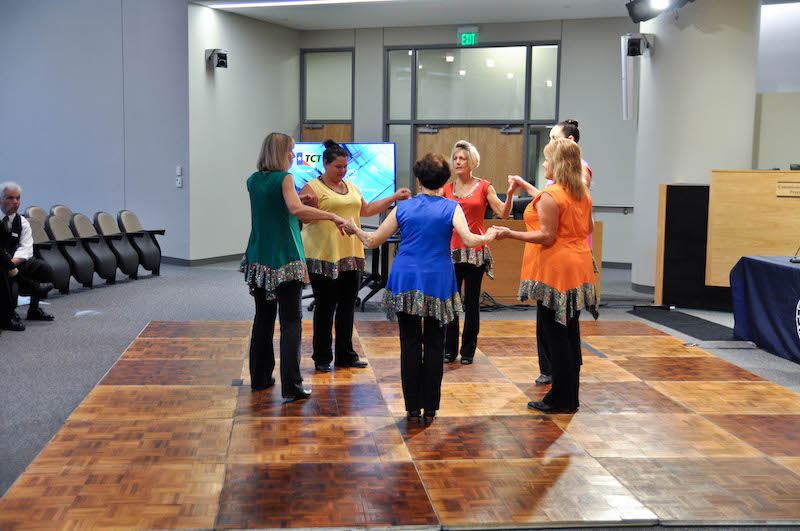History Day 2015
Crossroads of Culture:
Folk Art and Travis County’s Cultural Heritage
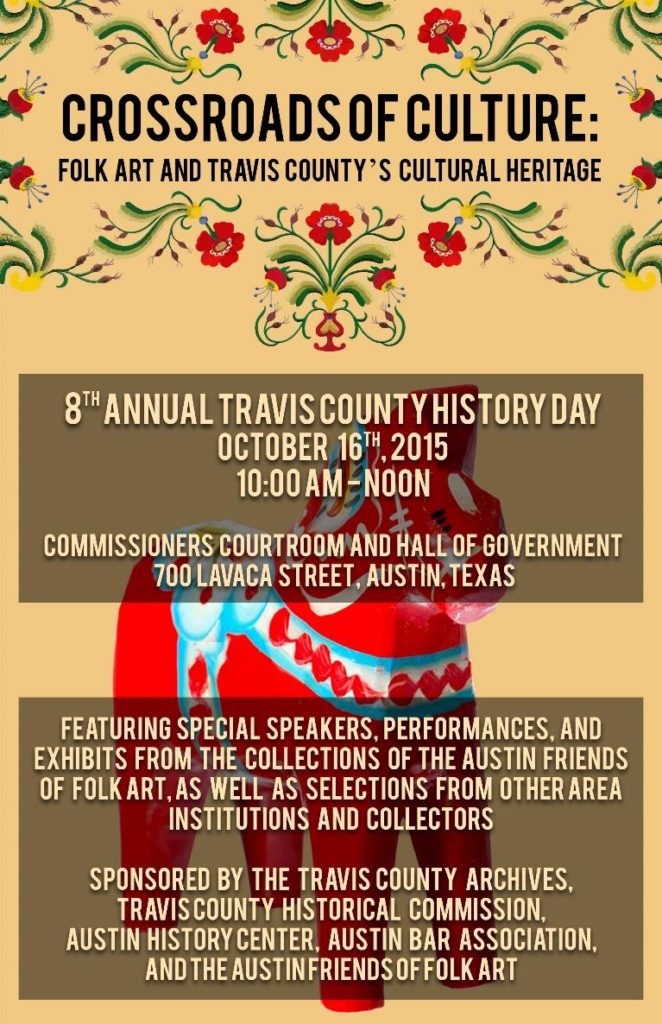
Held on October 16th, 2015, the 8th annual History Day event celebrated folk art and Travis County’s cultural heritage. The program was emceed by Commissioner Brigid Shea and featured speakers from the Austin Friends of Folk Art, including AFFA President Gloria Mata Pennington and members Ed Jordan, Jean Graham, and Dagmar Grieder. Musical performances were provided by the Melancholy Ramblers and the Fabulous Bureaucats and a clogging performance was provided by Contemporary Cloggers.
History Day exhibits featured a variety of folk art, folk artists, and exhibitors, including: The Austin Friends of Folk Art; Austin History Center; Dagmar Grieder; Doug Oliver; Ed Jordan; El Interior; Swedish Women’s Educational Association and Elisabeth Engquist Kihlberg; Emma S. Barrientos Mexican American Cultural Center; F. Weigl Ironworks; Martha Schreffler; Merry Wheaton; Polly Johnson; Texas Archaeology Resource Lab; quilters Dana DeBeauvoir, Belinda Powell, and Diana Ramirez; and the Weavers and Spinners Society of Austin.
Travis County is one of the most rapidly growing areas in Texas and in the country. Our unique past and diverse cultural heritage must be protected and preserved for generations to come. Culture gives the people of Travis County a connection to certain social values, beliefs, religions and customs, and it allows them to identify with others of similar mindsets and backgrounds. Cultural heritage helps provide sense of unity and belonging within a group and allows us to better understand previous generations and the history of where we come from.
One of the ways in which our cultural heritage is preserved is through folk art. Folk art expresses cultural identity by conveying shared community values and aesthetics. It encompasses a range of utilitarian and decorative media, including cloth, wood, paper, clay, metal and more. If traditional materials are inaccessible, new materials are often substituted, resulting in contemporary expressions of traditional folk art forms. Folk art reflects traditional art forms of diverse community groups — ethnic, tribal, religious, occupational, geographical, age- or gender-based — who identify with each other and society at large. Folk artists traditionally learn skills and techniques through apprenticeships in informal community settings, though they may also be formally educated. Folk art is simple, direct, and most always colorful.
Our Cultural Heritage
Cultural heritage is an expression of the ways of living developed by a community and passed on from generation to generation, including customs, practices, places, objects, artistic expressions and values. As an essential part of culture as a whole, cultural heritage contains these visible and tangible traces form antiquity to the recent past.
Cultural heritage is made up of many things large and small. We can see it in the buildings, townscapes, and in archaeological remains. Culture can be perceived through natural sources as well, in the agriculture and landscapes associated with it. It is preserved through books, artifacts, objects, pictures, photographs, art, and oral tradition. Cultural heritage is in the food we eat, the clothes we wear, the religions we follow, and the skills we learn. Sometimes we can touch and see what makes up a culture; other times it is intangible.
The culture of Texas is a complex blending and separation of cultures that different people originally brought with them to Texas. Texas is unique in that it is, and has been, a borderland – between the Atlantic World and the United States; between the western prairies and the Deep South; between Mexico, influenced by Spain and great civilizations of the Old World, and a world to the north, influenced by Anglo culture. It is also a place of communities from areas such as Germany, Czechoslovakia, Poland, Mexico, and Africa, and of historic tribes of Native Americans.
Travis County’s cultural history dates back much farther than the county’s 1840 establishment date. Archeological evidence dating from the Archaic Period suggests that hunting and gathering peoples established themselves in the region of modern day Travis County as early as 10,000 years ago. The Tonkawa and the Lipan Apache Indians were well established in Central Texas by the fourteenth century, and Comanche and Kiowa tribes arrived in the area by the eighteenth century.
The first European known to have crossed the region was Domingo Terán de los Ríos, who made an inspection tour to East Texas in 1691. When the Spanish moved their missions out of East Texas in 1730, they relocated three of them near to Barton Springs. In 1827, the Mexican government granted Stephen F. Austin his third colony, which was located east of the Colorado River and north and west of the Old San Antonio Road. The Mina municipality, later known as Bastrop, became the headquarters of the colony, and Travis County developed as an offshoot of Mina. The earliest Anglo settlers moved into the area in the early 1830s.
Travis County was established on January 25, 1840, and as settlement expanded and the county’s population grew, the ethnic makeup continued to change with a steady influx of new inhabitants. After the Civil War, many former slaves remained in the area, establishing communities such as Clarksville, Kincheonville, Masontown, and Wheatville. A variety of immigrant groups, the most prominent of which were German, Swedish, and Mexican, contributed to the diversity of Travis County by establishing communities and towns throughout the county. Mexican influence was greatly reinforced by the continued arrival of large numbers of new immigrants fleeing the unrest of the Mexican Revolution in the early twentieth century.
Today, Travis County continues to be one of the most rapidly growing areas in Texas and in the country. Our unique past and diverse cultural heritage need to be protected and preserved for generations to come. Culture gives the people of Travis County a connection to certain social values, beliefs, religions and customs, and it allows them to identify with others of similar mindsets and backgrounds. Cultural heritage helps provide sense of unity and belonging within a group and allows us to better understand previous generations and the history of where we come from.
Folk Art
One of the ways in which our cultural heritage is preserved is through folk art. Folk art encompasses art produced from an indigenous culture or by peasants or other laboring tradespeople. In contrast to fine art, folk art is primarily utilitarian and decorative rather than purely aesthetic. Because the construction and everything involved in folk art reveals much about the essential values or characteristics of a society, folk art is often studied by historians and anthropologists as an artistic window into what an ancient culture was like.
Folk art expresses cultural identity by conveying shared community values and aesthetics. It encompasses a range of utilitarian and decorative media, including cloth, wood, paper, clay, metal and more. If traditional materials are inaccessible, new materials are often substituted, resulting in contemporary expressions of traditional folk art forms. Folk art reflects traditional art forms of diverse community groups — ethnic, tribal, religious, occupational, geographical, age- or gender-based — who identify with each other and society at large. Folk artists traditionally learn skills and techniques through apprenticeships in informal community settings, though they may also be formally educated. Folk art is simple, direct, and almost always colorful.
Functional objects like clothing, furniture, houses, and kitchen utensils are often considered folk art because although they are everyday objects, their final form carries a certain beauty, expression and significance that elevates the objects above the daily mundane to the inspired artistic. Folk art is not only something that was made or created by generations long ago, either. Folk art is still being produced around the world.
Native American Folk Art
The earliest traditional artisans in Texas were Native Americans, made crafts using available materials and decorated their artifacts and themselves with symbols of their cultures. Native American folk art emerged during the late nineteenth century as a genre that synthesized traditional American Indian art forms with influences from greater American society. By that time, many American Indian tribes had been displaced from their original territories and relocated on reservations. As a result, historic art styles were disrupted and a new creative vocabulary was born. Early American Indian folk art looked backward to artistic antecedents and forward to eclectic use of introduced ideas and materials. Even in the Southwest, where most Native groups were not resettled, the influence of new materials, commercial goods, and tourists stimulated departures from previous artistic repertoires. As the twentieth century unfolded, Native American folk art became increasingly innovative, venturing even further from conventional aesthetic norms.
Although most Native American folk artists were self-taught, folk art traditions were passed along within families, with elders serving as mentors to younger generations. Prior to the twentieth century, the production of objects was an integral part of everyday life; hence most makers were unknown outside their tribal boundaries. With the development of a vital art market during the last half of the twentieth century, name recognition became increasingly important. The art market also supported the revival of old traditions and the invention of new ones. The responsive economic environment attracted artists of all ages including many talented young artists. By the end of the 20th century, the state of Native American folk art was lively and dynamic.
Some of the more prevalent Native American folk art forms include baskets of varying shapes and sizes; utilitarian and ceremonial pottery; clay figures; personal adornment in the form of quillwork, beadwork and stitched patchwork; quilts; jewelry and silverwork; pictorial textiles; and wood carvings of human and animal figures.
Mexican and Latin American Folk Art
Mexican folk art is a complex collection of items made with various materials and intended for utilitarian, decorative or other purposes. Some of the items produced by hand in this country include ceramics, metalworking, wall hangings, vases, furniture, textiles and much more. In Mexico, both crafts created for utilitarian purposes and folk art are collectively known as “artesanía,” as both have a similar history and both are a valued part of Mexico’s national identity. Artesanía can be defined as those items created by common people, using traditional methods which are well-founded in the past. Most artisans do not have school-based training in their craft, but rather learn it through formal or informal apprenticeship.
Most of the artesanía produced in Mexico are ordinary things made for daily use, but they are still considered artistic because the majority contain decorative details and/or are painted in bright colors for aesthetic purposes. The bold use of colors in crafts and other constructions extends back into pre-Hispanic times. Pyramids, temples, murals, textiles and religious objects were painted or colored ochre red, bright green, burnt orange, various yellows and turquoise. These would be joined by other colors introduced by European and Asian contact, but always in bold tones.
The most prevalent of Mexico’s crafts is ceramics and pottery. Ceramics was considered one of the highest art forms during the Aztec Empire, with the knowledge of making pottery said to have come from the god Quetzalcoatl himself. Pre-Hispanic pottery was made by coiling the clay into a circle then up the sides, then scraping and molding the coiled work until the coils could no longer be detected. The Spanish introduced the potters’ wheel and new glazing techniques. Majolica glazed pottery was introduced by the Spanish. Puebla in particular is renowned for its variety of Majolica, which is called Talavera. One distinctive feature of this city is that many kitchens and buildings are decorated with intricately detailed Talavera tiles. Tiles are a subset of ceramic pottery and were used extensively in colonial-era Mexico.
Metalworking was also prevalent in Mesoamerica, particularly of silver, gold and copper. Gold was inlaid into copper and metals were hammered to paper thinness and cast using the lost wax method. Some copper and iron tools were produced, but pre-Hispanic metal craft was dominated by jewelry and ornaments. The Spanish introduced new techniques such as filigree work, where tiny threads of metal are strung together to make jewelry.
Textile work in Mexico features the twisting, knotting and weaving of many different fibers into textiles and objects, such as placemats, baskets, hats and bags. Woven textiles were known to pre-Hispanic cultures for hundreds of years before the arrival of the Spanish, using a back-strap loom fastened between a tree and the weaver’s back. The Spanish introduced the treadle loom, which can make larger pieces of cloth. Historically, fibers were dyed using pigments created from plants and animals. Synthetic dyes have replaced natural ones for many craftspeople, but there still are some, especially in Oaxaca, that still use traditional dyes. The agave plant was an important source of fibers and thread and is still used to day for thread and paper. Cotton was also used, spun into thread by itself or combined with feathers or animal fur to provide warmth. Very traditional Mexican women still spin their own thread, which are made from cotton or wool and can be very fine or very coarse. Textiles have long history of tradition. Brightly colored embroidered designs on female garments can identify tribe, age, and marital status of the wearer.
Leatherwork in Mexico is closely tied to the vaquero, or cowboy tradition, focusing on the creation of saddles, belts and boots. Leatherwork is traditionally decorated with flowing patterns using the labor-intensive punch and tool method and colored with dye or varnish.
Ceremonial objects are produced in every region of the country in all different shapes, sizes and colors, whose sole purpose is to celebrate saints and holidays and honor the dead. One of the major holidays for artesanía is Day of the Dead. Objects are created to decorate houses and create “ofrendas” (altars to the deceased) such as candy skulls, decorated skeletons. Another major holiday for crafts is the Christmas season, where sales of piñatas peak and ornate nativity scenes are constructed in homes. For Palm Sunday, intricate crosses are woven from palm fronds. In some places in Mexico during Holy Week, large papier-mâché effigies of Judas Iscariot are ritually burned. For the feast days of patron saints, cut paper banners are strung over roads and hung in windows.
Mexican-American folk arts and crafts have thrived in Texas since the beginning of the state. They include the production of widely varying elements of material culture, including saddles, quilts, roadside crosses, wrought-iron work, ceramics, and yard shrines. In some cases, these arts and crafts perform the private function of decorating the home or other family space, thus earning their creators an important role within the Mexican-American community but bringing them no monetary compensation. From other crafts, such as guitar and piñata making, individuals may derive a true livelihood.
Mexican-American folk arts and crafts, though linked to the pottery, metal work, leather work, and weaving of the pre-Columbian, Spanish, and Mestizo heritages in Mexico, have nonetheless developed from specific Tejano culture. Beginning with the establishment of missions along the border, Tejanos plied their abilities as weavers, furniture makers, and stone carvers. Their involvement grew so that by the 1850 state census approximately 16 percent of Tejano males were listed as artisans, a fact that reveals the importance of traditional arts and crafts in daily life.
African-American Folk Art
rom its early origins in slave communities, through the end of the twentieth century, African American art has made a vital contribution to the art of the United States. During the period between the seventeenth century and the early nineteenth century, African American folk art took the form of small drums, quilts, baskets, wrought-iron figures and ceramic vessels in the southern United States; these artifacts have similarities with comparable crafts in West and Central Africa.
Many slaves arrived from Africa as skilled artisans, having worked in these or similar media in Africa. Others learned their trades or crafts as apprentices to African or white skilled workers. It was often the practice for slave owners to hire out skilled artisans. With the consent of their masters, some slave artisans were able to keep wages earned in their free time and thereby save enough money to purchase their, and their families’, freedom.
Blacksmiths entering Texas as slaves were extremely valuable to their owners, particularly since they made most of the tools other craftsmen required in their work. Other slaves afforded these ironworkers high status and looked upon them as leaders. Artists in iron, who made fancy bridle bits, gal-leg spurs, and decorative iron gates, were found among both professionals and amateurs.
The African American quilting tradition dates back to the slavery era. Since making textiles and clothing was central to plantation life, a slave with an aptitude for sewing, weaving, spinning, and/or quilting was likely to be valued. It was common for slave women to work with their white mistresses on quilts for the household. Quilts served as both utilitarian bedding and folk art objects. Like the pioneer quilters, early African American quilters were quite resourceful in finding and using “throw away” or discarded goods to use in their quilts. In addition to scraps from cloth used to make their clothes, slave quilters made good use of gunny, feed, flour, tobacco, and sugar sacks. The inner layer of quilts could be filled with old blankets, worn clothes that could no longer be mended, or bits and pieces of wool or raw cotton.
Other forms of African American folk art over the years include yard shows using throwaway objects, stone work (such as soul effigies and tombstone carvings), woodcarving, and wrought-iron work. However, the unknown provenances of African American craft objects muddy attempts to identify any traits particular to African American artisans.
European and Anglo Settler Folk Art
Folk art in Texas was largely influenced by many of the European cultures that were brought by settlers to the area. Each cultural group that came to inhabit Texas brought its own traditions and artistic styles. English, Scot, Irish, and assimilated Germans moved into the state from cultural regions centered in the Upper South and the Tidewater region. Czech, Polish, Norwegian, and Swedish settlers came directly from Europe, and Europeans of all sorts came who had first sojourned elsewhere in North American. The French came both from Louisiana and directly from Europe. These groups brought their own customs with them but often changed their traditions as a result of the new environment, of the influence of new neighbors, and of changing artistic styles
The European settlers of the nineteenth century came with all sorts of skills and as many concepts of art as ethnic groups. They brought, bought, or made spinning wheels, looms, cotton carders, and other tools of the textile craft. They separated themselves from the weavers of skin by their skills in making fabrics of wool, cotton, and flax. They stripped, colored and shaded the materials according to their artistic tastes. As they adapted to their new environment they crafted what they could, used what was available, and learned from each other.
Because they brought little furniture with them, they began their new lives on the frontier with the roughest of tables and chairs and bedsteads. Factories in the northern states began manufacturing furniture in the 1830s, but handcraftsmen flourished long after that in Texas because of transportation problems. Many of the Europeans who came to Texas brought a long tradition of woodcrafting, including ship and house building, shaping of weapons and tools, plows and wagons, axe and hammer handles, of treenware (small domestic wooden objects) and furniture crafting.
German cabinetmakers who had been apprenticed in Europe became the leading artisans in the Hill Country and southeastern bottomlands. They introduced Texans to furniture in the Gothic and Renaissance styles, and each craftsman had his own individual style. Although the craft declined with the improvement of transportation and the availability of cheaper, manufactured furniture in the 1870s, furniture making was one of the most representative folk art expressions in early North American Germanic communities. In 1860, when only six percent of Texas’s population was German-born, Germans comprised 33 percent of the cabinetmakers listed on the census. Fredericksburg, in particular, had an intense concentration of cabinetmakers who made furniture for German settlers throughout the Texas Hill Country. Many of the German cabinetmakers worked in the Biedermeier style, which was popular in Germany and Central Europe between 1815 and 1850. This style emphasized plain, flat surfaces; gentle curves, especially in legs and chair backs, stylized decorative motifs from nature; and construction techniques that emphasized the natural beauty of the wood.
Czech American folk art is rooted in the Moravian and Bohemian communities that arose in the United States in the eighteenth and nineteenth centuries. Czech Moravians established communities in places such as Schulenberg and West, Texas, where many immigrants worked as farmers. For many of these new Czech immigrants in the United States, preserving their culture and traditional way of life was especially important and folk art became a way for many of them to maintain a connection to their culture and ethnic identity. Woodcarving, ceramics, embroidery, and crèches, or paper or wood cut nativity scenes, were some of the many forms of folk art created by Czech Americans. Two of the most popular forms of folk art across the many Czech American communities were painted Easter eggs and traditional folk costumes.
The practice of painting Easter eggs is a folk art tradition of many Easter European cultures and derives from ancient cults in which the egg symbolized fertility, renewal, life, and birth. In Czech culture these eggs are known as kraslice and are hand decorated with colorful designs. Folk costume and objects of personal adornment are also important parts of the folk art traditions of the Czech people. The traditional folk costumes of the Czech people are known as kroje. Although the components of the kroje were similar across the regions of Czechoslovakia, there were distinguishing features that made each local costume different. These distinguishing features included embroidery, colors, geometric shapes, ornaments, flowers, and the style of the woman’s blouses, kerchiefs, and lace. These folk costumes continue to be worn and produced in the United States and have been traditionally worn during performances of dances and songs, events on the church calendar, community festivals, and parades celebrating national holidays.
Contemporary and Outsider Folk Art
Contemporary folk art
A new interest in more recent folk art began around 1970 with a few collectors and artists who, through travels on back roads, local fairs, and word-of-mouth, began to realize that a large group of individuals existed who whittled, painted, welded, and assembled objects that might be called folk art. This discovery came at a time of unrest in the United States, concurrent with the Civil Rights movement and the Vietnam War. Pop Art was expanding the categories of subject matter for art, music and festivals were generating a new interest in folk expressions, and academia was shifting away from the study of great men toward an interest in the life of the common person.
By the later-1980s, a full-fledged contemporary folk art boom emerged with major exhibitions at prestigious museums, new galleries ranging from storefront operations to high-end dealers, and the requisite books, symposiums, and organizations devoted to promoting the work. Initially, most contemporary folk art appeared to be made by rural or small town untrained individuals, both black and white, from the South or Appalachia. In more recent years, the field of contemporary American folk art has expanded. Included in the folk art pantheon today are works by individuals with handicaps and disabilities, along with “found art,” such as signs, muffler men, and work produced in big cities and suburbs across the country.
Accompanying the recognition of contemporary folk art are criticisms about commercialism, consumption, quality, collecting, exploitation, exclusion, and meaning as well as questions about its relation to the larger art world.
Contemporary American folk art contains such variety that any attempt to categorize it becomes difficult. Still, there are some broad characteristics. A striking element is the diversity of media and scale, from painted canvases to painted gourds, and from massive yard environments consisting of found objects to small clay or concrete sculpture that can be held in one hand. Many folk artists start with found elements, such as pieces of tin, discarded doors, broken bits of glass, cardboard, and trash, then with income from sales purchase precut pieces of plywood or even pre-stretched canvases. Whether this devalues the art is a hotly debated topic, but it can indicate that the artist has achieved some type of recognition. Technique or skill in manipulating materials to illuminate the human hand with a degree of crudeness, or untrained ability, is another aspect frequently noted.
The content of contemporary folk art is equally diverse. The portrait, whether of a person, animal, or flowers, is a staple of folk art. In some cases the images are self-portraits or individualized, but frequently they stand for anonymous individuals or the everyman. The same is true of three-dimensional statues, which can take on greater meaning as talismans and icons. Patriotism, often interwoven with religion, reappears constantly as do views of buildings, towns, and cities.
Contemporary American folk art contains many of the themes and issues that artists always have found of importance. Some of the themes are evident, others withdrawn and submerged. Profound work exists along with the ephemeral and trivial. The folk artist is seldom totally withdrawn from society, and current events and even art world concerns can impact the maker. Making art involves skill and technique but most importantly a vision and a language with which to communicate. Great visions or profound insights can come from many quarters. French artist Jean Dubuffet once explained: “True art is always to be found where one least expects it, there where no one is thinking of it, or mentioning its name.”
Outsider Art
Simply put, outsider art is art made by people who are “outside” the loose system of professional art schools, galleries, distributors, and collectors. The art is usually quite original – often with a raw, earthy beauty or power.
The term “outsider art” was coined by art critic Roger Cardinal in 1972 as an English synonym for art brut (French for “raw art” or “rough art”). Art brut was a label created by French artist Jean Dubuffet to describe art created outside the boundaries of official culture. Dubuffet was particularly interested by the drawings of mental patients that he saw in Switzerland in 1945.
The English term “outsider art” is applied broadly, to include certain self-taught or naïve art makers who are outside the artistic establishment. Outsider art is made by people who have not achieved fame or fortune or been anointed as “the artist to watch” or “up-and-coming” or “established” by the powers that be – namely, gallery owners, collectors, and journalists. Typically, those labeled as outsider artists have little or no contact with the mainstream art world or art institutions. “Self-taught” is a more encompassing expression that includes people living mainstream lives, who were not trained as artists, but who make art.

